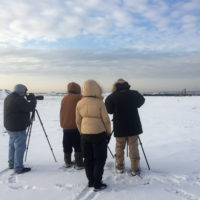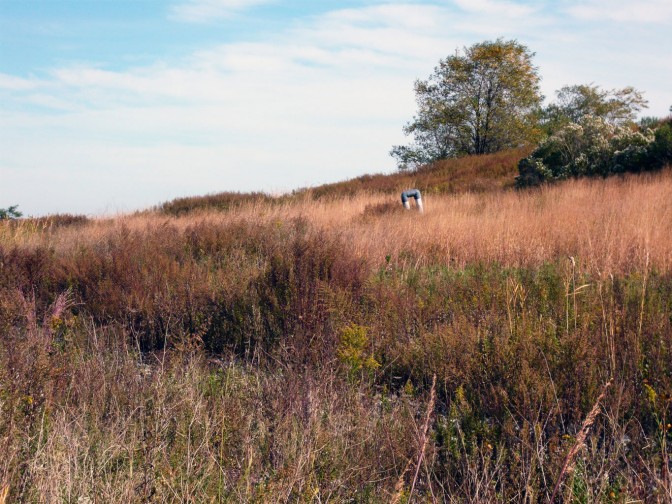Tags: research
Community Science Spotlight: Spotted Lanternfly Monitoring

Students across New York City are visiting Freshkills Park to collect data on invasive species and take action to protect this reclaimed ecosystem.
There is a newcomer to the grasslands and wetlands in Freshkills Park: spotted lanternflies, an invasive species that can wreak havoc on trees and other plants.
...MOREInteractive Site Map Provides Snapshot of Freshkills Park
As Freshkills Park undergoes its long transformation from landfill to public greenspace, access remains limited and it can be challenging to convey to the public all of the things going on inside the park’s boundaries. The Freshkills Park Development team has created an interactive map to serve as a virtual tour of the park project.
...MOREFourth Year of Bird Banding Reveals New Species

Monitoring Avian Productivity and Survivorship
This summer, researchers from College of Staten Island completed their fourth year of Monitoring Avian Productivity and Survivorship (MAPS) bird banding at Freshkills Park. MAPS is a collaborative, continent-wide research effort coordinated by the Institute for Bird Populations, with over 1,200 participant banding stations.
...MORESoil Moisture Research Provides Insight into Grassland Bird Preferences

This summer, Freshkills staff and interns conducted fieldwork to assess the levels of moisture in the grassland soil on North and East Mounds. This research is part of an ongoing project to characterize the differences between the grasslands within Freshkills Park.
...MOREFish Monitoring Seining Program Continues in 2019

Throughout August, Freshkills Park researchers have been monitoring the diversity of fish species in the park’s Main Creek. This research has been ongoing since 2016 as a means of staying up to date on the health and quality of the aquatic ecosystems at the park.
...MORERed Fox Monitoring Project at Freshkills Park

The red fox, one of Staten Island’s rarest and most elusive mammals, is now living in what was once the world’s largest landfill. Prompted by occasional sightings, our science team has set up specially designed motion sensor cameras to capture any movement of wildlife within Freshkills Park.
...MOREFreshkills Park hosts Grasslands-themed dinner and discussion

On June 25, Freshkills Park staff and local Staten Island residents came together at the Greenbelt Nature Center to participate in the first ever “Grasslands Dinner.” The evening centered on the history of grasslands in the United States, the biodiversity of plants and animals associated with these habitats, and how Freshkills Park is helping to bring grassland back to New York City.
...MOREGrassland Research Continues for Fourth Year

This spring, staff and interns will continue studying the grasslands at Freshkills Park. The research project is working to characterize the structure and diversity of the grasslands on two of the capped landfill mounds. Large populations of grassland birds have been nesting at East Mound, but not North Mound.
...MOREBackground Noise Study Results

This summer Freshkills Park staff and interns partnered with the NYC Parks Wildlife Unit to evaluate differences in ambient noise levels between two areas of the park. To track the noise levels, sound recorders were placed at corresponding locations on North and East Mounds.
...MORESeining Provides Snapshot of Fish Population

In 2018, NYC Parks researchers monitored the fish species in the waterways of Freshkills Park. This ongoing research has helped to document the fish in the creeks since 2016. The data provide insight into the health of the fish populations, as well as the food availability for wading birds like the great egrets and great blue herons seen foraging in the park.
...MORENest Monitoring Shows Osprey Population on the Rise

By early April, ospreys had arrived at Freshkills Park after spending the winter in warmer places. Nicknamed “fish hawks,” these large raptors like being close to shallow water for easy access to food. The birds quickly got to work building their summer homes on tall platforms close to the creeks.
...MOREExploring Background Noise Levels

A new research project is being developed at Freshkills, and it’s a noisy one. Staff and interns will partner with members of the NYC Parks Wildlife Unit to place sound meters around the park to compare ambient noise levels between two areas.
...MOREThird Year of Grassland Research Begins

The closure of the Fresh Kills Landfill and the planting of native grasses atop the landfill cap has led to hundreds of acres of new grasslands. This offers the unusual chance to see a nascent ecosystem take shape, bringing its value as a specialized habitat with environmental benefits to the forefront.
...MOREScience and Research Intern: Kaitlyn Brudecki

Kaitlyn Brudecki is a Science and Research Intern for the Freshkills Park project. She grew up in Greenpoint, Brooklyn then later moved to Middle Village, Queens. She studies Aquaculture at the Urban Assembly New York Harbor School.
What are you working on?
...MOREThe Value of Research in Reclaimed Urban Spaces

At five o’clock in the morning, a team of researchers enter Freshkills Park, passing flare stations and winding through the roads that border the park’s rolling hills to get to their workstation. The sun is just beginning to break as they unfurl their mist nets in an opening in a stand of trees and set up a table with tiny metal bands, clamps, clipboards, scales, rulers, and pencils.
...MOREReintroducing Natural Systems to Create Healthier, More Resilient Cities

Storm surges reached near record highs in Boston during an intense winter storm early this year. Storms are being seen with increasing strength and frequency throughout the country, and they’re being coupled with increasing costs of repairs and restorations. This has given rise to creative mitigation strategies to limit the impact of severe weather events.
...MORE2017 in Review

In November of 2017, Freshkills Park celebrated the groundbreaking at North Park. The event signaled the start of construction on the 21-acre project, which will be the first section inside the Fresh Kills Landfill boundaries to become public parkland. This milestone was possible thanks in part to the growing community that is engaging with the project and participating in scheduled programs.
...MORE2017 Christmas Bird Count Results

The 2017 Christmas Bird Count took place in Staten Island on Saturday, December 16. As part of this yearly tradition, Staten Islanders spread across the Island to count as many different species as possible. This year there was a myriad of species found within Freshkills Park and across the Island.
...MOREGrassland Research Continues at Freshkills Park

With the decline of grassland habitat, less than 1% of original grasslands remain in the Northeast. Meanwhile, the mounds of the Fresh Kills Landfill have been covered by a cap and seeded with native plants, and the engineered grasslands at Freshkills Park are providing vital habitat to many bird species dependent upon them.
...MOREMonitoring the Waterways of Freshkills Park

Between June and September, NYC Parks staff conducted weekly water testing at the park to look at the health of the waterways. NYC Sanitation regularly conducts tests to monitor the air, surface water and groundwater at Freshkills Park. While the data that Sanitation collects is used to assess the effectiveness of the landfill infrastructure, this testing was focused on tracking the site’s restoration from an ecological perspective.
...MORE



